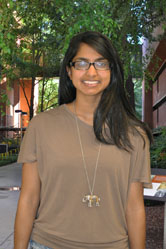Bioinformatics & Computational Biology
“Extracting Interacting Orthologs from Literature”

Information about protein-protein interaction is essential to understand function within cells, pathways and relationship to diseases. Most interactions are not available in the databases. We hypothesize that protein interaction evidence conserved across species (interologs) can be used to uncover positive interactions. A novel methodology, LIGER, was developed to retrieve interologs from the literature. LIGER retrieved mouse interactions using the human orthologs to direct the extraction from literature. A set of human protein interactions built from the STRING database was used as a starting point (seed) to identify putative mouse interactions (target). We used HomoloGene to retrieve all mouse orthologs to human, to build a database of putative mouse protein-protein interactions. Our methodology performs a search for mouse interactions in PubMed defined by their orthology to human. LIGER retrieved 2846 unique mouse protein-protein interactions, 2103 were true positives after manual curation, corresponding to 21% of known mouse interactions. LIGER retrieved 1774 interactions missing in the protein interaction mouse database. The high precision reflects that interologs are more likely to be positive interactions than just any two genes co-occurring in the literature. We are currently implementing a version that uses multiple organisms as seed to increase the sensitivity of the method.
How did you find your mentor for year research project?
Through the Howard Hughes Medical Institute Scholars Program.
How did you know this was the project you wanted to do?
I chose the lab because of the friendly environment, the skills I knew I would be learning, and the idea of developing a tool that could be useful for the scientific community.
Is this your first independent research project?
Yes.
Do you get course credit for this work?
Yes, it counts for an upper level biology elective.
How much time do you put into it?
I put it in about 12 hours a week.
How did you hear about the Undergraduate Research Award (URA) program?
A fellow undergraduate in the lab received a URA.
What academic background did you have before you applied for the URA?
When I applied, I had 2.5 years of undergraduate courses. This includes Biology, Chemistry, Math, Physics, Statistics and Computer Science.
Was the application difficult to do?
No, because I have written abstracts before and I was very familiar with my work.
How much did your mentor help you with the application?
I wrote the application independently and she reviewed and edited it.
What has been the hardest part about your research?
The hardest part about the research is evaluating my method. It’s a unique method and is hard to find other methods out there to compare it to.
How does your research relate to your work in other classes?
My research relates to the skills I learned in my computer science classes and it can be applied to the information I learn in my biology classes.
What else are you involved in on campus?
I am president of Hindu Students Council and a member of UMBC ADAA, and the South Asian fusion dance team
What is your advice to other students about getting involved in research?
“What is research, but a blind date with knowledge.” -William Henry
What you learn from books and lectures is incomparable to the information and skills you learn from being involved in research. In my opinion, a great research experience is based on how much you learned and what skills you gained from the experience.
What are your career goals?
I will be applying to PhD programs this Fall. As I work towards completing my PhD, I will better understand whether or not I want to stay in academia, work for the government, or go into industry. I eventually would like to teach at the college level.
Did you transfer to UMBC from another institution? Where?
No.
7/19/2013